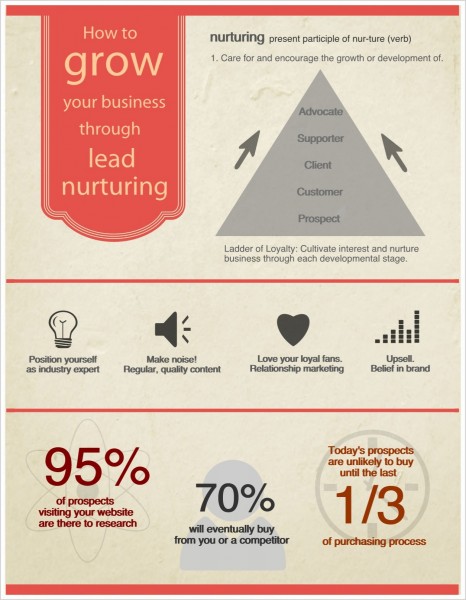Lead nurturing is the acknowledgement of, and investment in, new and existing business opportunities with the intention of developing a loyal following and encouraging repeat business.
This kind of relationship marketing relies on a solid understanding of your target market and a tailored approach to marketing activities. Different engagement approaches need to be applied at varying stages of the customer journey to move the individual upwards on the ladder of loyalty, until they reach 'brand ambassador' status.
Research conducted by Marketo indicates that companies investing in lead nurturing campaigns generate on average, 50% more sales-ready leads at 33% lower cost per lead.
Follow.these simple steps to prepare your own lead cultivation campaign
Step 1: Who to target
Individuals at differing levels of engagement will demand different marketing approaches.
- New leads - position yourself as an expert in your industry by providing answers to frequently asked questions, blogging, writing articles and preparing guides to convert leads to sales.
- Existing leads - provide consistent, relevant and timely information to reassure existing, un-converted leads that you haven't forgotten them. Remind them why they should choose you with high quality, appropriate content presented at a time and place convenient for them.
- New clients - welcome your new clients with personalised communications, e.g. e-marketing mailers that thank them for choosing you. Include in special 'members only' offers and advise of product/service updates to encourage repeat purchases.
- Existing clients - the intention here is to maintain a strong relationship and up-sell. Leverage purchasing power and capitalise on an established 'belief' in your brand. Provide this target group with access to 'exclusive' industry information and thought pieces to subtly sell and convince customers of your legibility.
Target market profiling - it helps to know who you're talking to.
Segment your target market and conduct detailed research to determine the key demographics and psychographics of each target group. You can collect this data and segment your customer's in-house using free survey tools (such as Survey Monkey) and online tracking tools (Google Analytics), or by using a market research agency which will be more costly but provide greater detail.
Marketing Donut offers free 'how to' information and access to resources to help you manage accurate market analysis.
Know your customer, know your content.
Increase customer value by focusing your lead nurturing campaign on customers whose behaviour you are most likely to be able to influence, and those that hold the greatest potential value (revenue/longevity) for your business.
Step 2: What to say
Devising your lead nurturing campaign
Firstly, identify exactly what it is that you are you going to promote and deliver. Build relevant offers and provide relevant information based on historical data, i.e. what has/hasn't worked before, and predicted behaviours.
What can you offer that nobody else can? Perhaps it's expertise on how best to maximise business efficiencies. In which case, create content and integrate communications on this subject via:
- Direct mail
- Downloadable whitepapers/brochures/guides
- Blogging, website, SEO, social media
Once you have established what you want to say, you need to determine why your customers should choose you. Position yourself as an industry expert through the provision of reliable, knowledgeable and consistent communications to organically build trust with your leads.
Make sure that content is available at a convenient time and place. Consider A/B testing communication frequencies to gain greater insight into how often different target groups expect to be communicated with.
Tip: Consider format. Audiences will want to receive information in different ways, which could include: document, podcast, video, presentation or infographic. Reproduce content in different formats.
Step 3: Measure your engagement efforts
Measure your campaign against past activity, industry data and competitor activity, and conduct A/B testing to see how different communication techniques work with different target segments.
Lead nurturing campaigns are exactly that; it's a matter of nurturing - changing and adapting marketing approaches to suit different stages of engagement. It's an ongoing, cyclical process.
Cultivate interest by adopting an integrated approach to communications and focus on information sharing rather than sales orientation to earn trust and loyalty from your lead pool.

